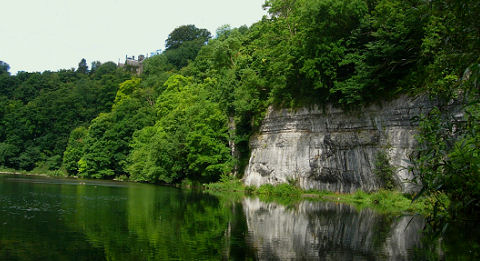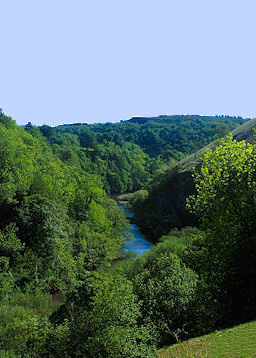Water-Cum-Jolly Dale
OS grid ref:- SK168727
 Curiously named Water-Cum-Jolly Dale is a small, picturesque dale, situated downstream of Litton Mill and Millers Dale in the spectacular Peak District National Park.
Curiously named Water-Cum-Jolly Dale is a small, picturesque dale, situated downstream of Litton Mill and Millers Dale in the spectacular Peak District National Park.
 The River Wye begins to widen in Water-Cum-Jolly Dale forming a large millpond, which the path skirts round under overhanging spectacular limestone cliffs, which are popular with climbers. Coot, water-hens, swans, ducks, dippers, grebe and kingfishers can all be sighted in the dale.
The River Wye begins to widen in Water-Cum-Jolly Dale forming a large millpond, which the path skirts round under overhanging spectacular limestone cliffs, which are popular with climbers. Coot, water-hens, swans, ducks, dippers, grebe and kingfishers can all be sighted in the dale.
Across the road from Cressbrook Mill and Water-cum-Jolly is the site of the original Cressbrook Mill. The site was developed in the eighteenth century by John Baker who built a distillery for peppermint and lavender which were sourced locally. The first Cressbrook Mill was built around 1785 but was destroyed by fire. A new mill was erected which was taken over by Sir Richard Arkwright. When Arkwright died in 1792, Cressbrook Mill came under new management. The present Georgian mill building was erected in 1815 by the poet William Newton, the son of a carpenter from Abney and a friend of the Derbyshire poet Anna Seward of Eyam who bestowed on him the title 'Minstrel of the Peak'.
Newton built a school and a row of cottages near Cressbrook Mill for his workers, he died on 3 November 1830 at Tideswell, in 1834, the cruel practice of gibbetting was abolished in Derbyshire and a poem by Newton was given much of the credit. The mill closed down in 1965 and has now been converted to luxury apartments.
The dale can be accessed from the car park at Monsal Head which is about a mile away. A riverside track runs through Water-cum-Jolly up to Litton Mill (which can become waterlogged and liable to flooding in the winter). A footpath across the weir in the dale leads up the hillside to join the Monsal Trail to the Monsal Viaduct.
